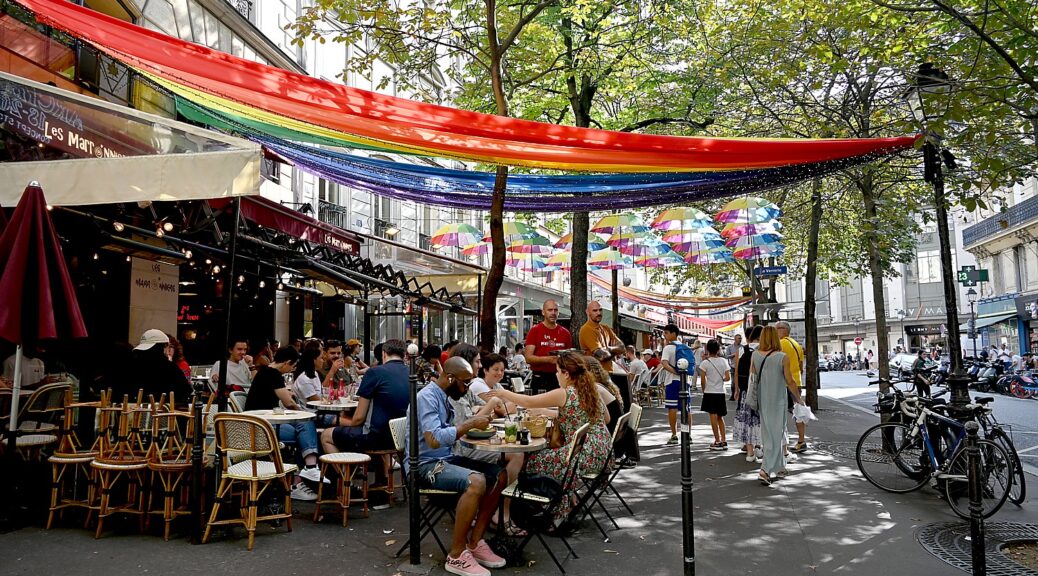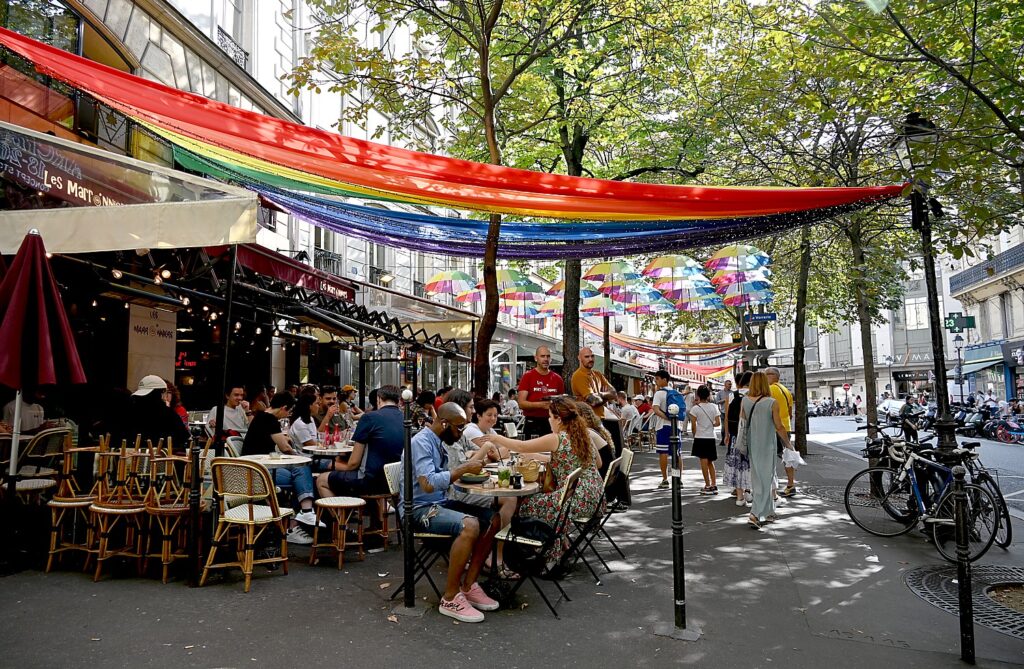
By Karen Rubin, Travel Features Syndicate, goingplacesfarandnear.com
On the third and last full day of my stay in Paris, I could have planned a visit to Versailles, but I just want a day to wander without a plan. Still, I have on my list several places that I keep seeing street signs for in this fascinating Marais district where I have cleverly chosen a hotel.
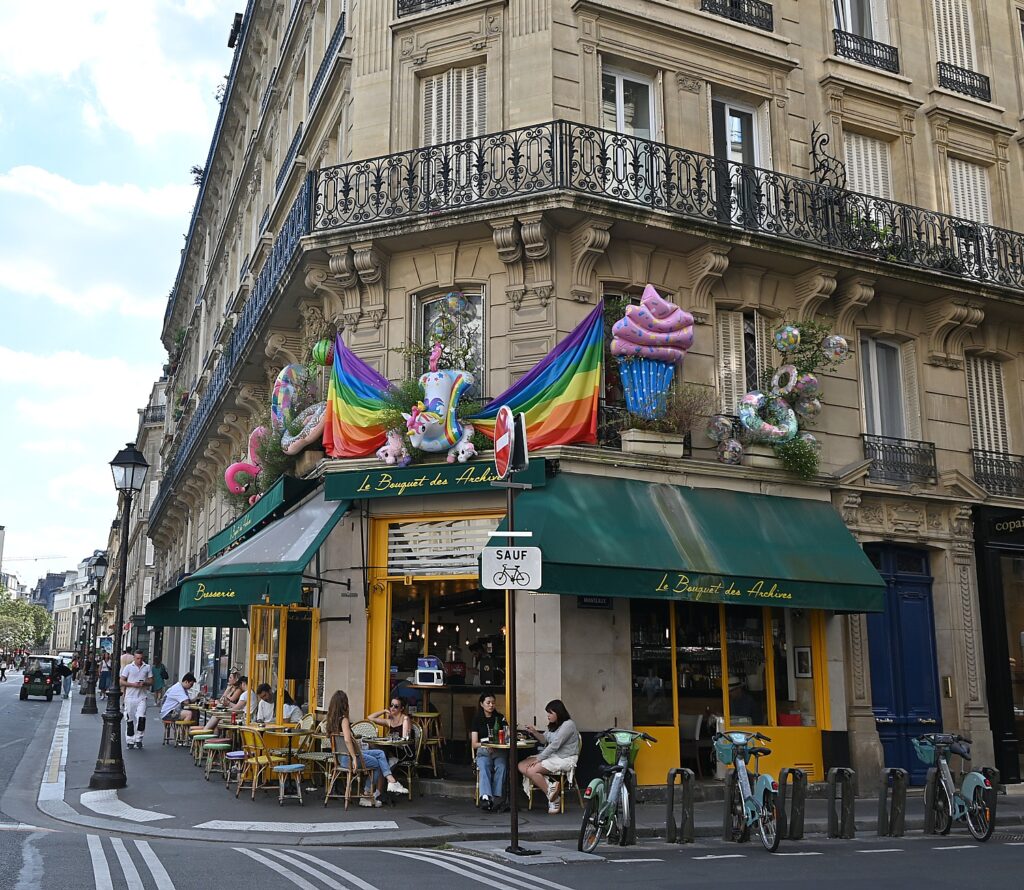
The Marais District is a colorful combination of the venerable and contemporary, trendy cafes, a mélange of architecture and historic, heritage and cultural sites, all packed into a relatively small (walkable) area. It is particularly wonderful to wander because the narrow, winding streets are a bit of a maze, and you keep coming upon architectural jewels – even a medieval tower – that span the centuries, trendy cafes and shops, street art, and historic places, especially sites that recall that the Marais was once a Jewish neighborhood. The main thoroughfare is Rue Vielle du Temple, and another is Rue du Temple. I had already come upon the Memorial de la Shoah, and have yet to find the Square du Temple-Elie Wiesel, le Carreau du Temple, a former clothes market that was transformed into a cultural center in 2014, or the Jardin Anne Frank.
I go in search of Place des Vosges, described as the oldest public square in Paris and an “early urban planning marvel”.
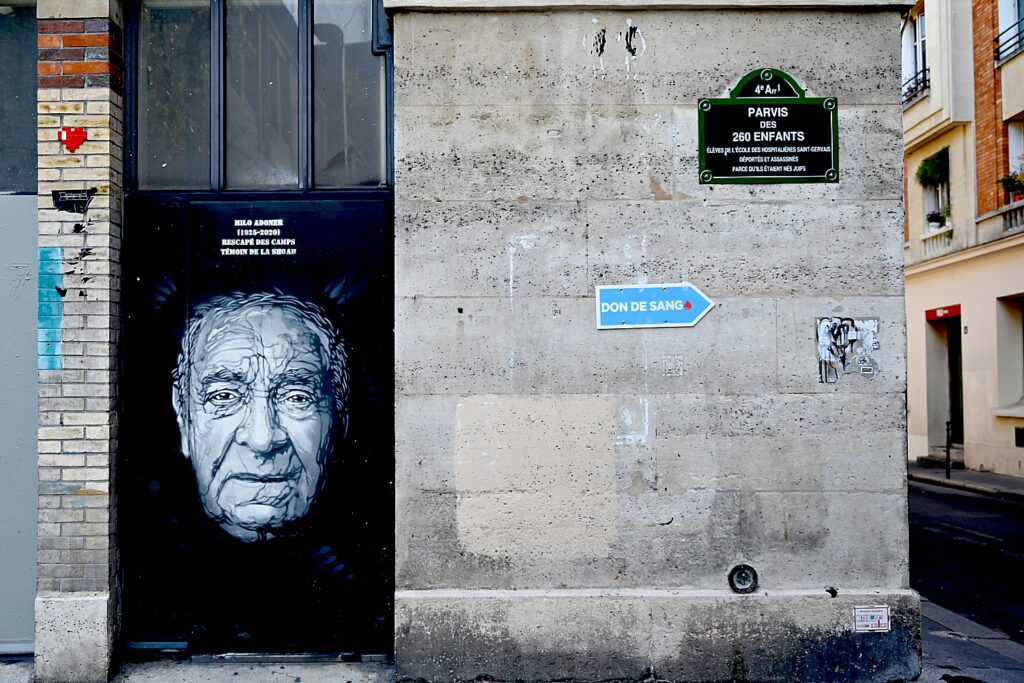
I get lost and instead come upon Parvis des 260 Enfants – a plaza where a marker recalls 260 Jewish school children were deported and murdered in the Holocaust. Behind a locked gate is the “Ecole Primaire Commudej Garcons Israelites Mode Mutuel.”
I finally find the Places des Vosges – which strikes me as reminiscent of Gramercy Park in Manhattan with townhouses all around. It was built for a king for jousting and festivals – the townhouses came later. It isn’t what I expected.
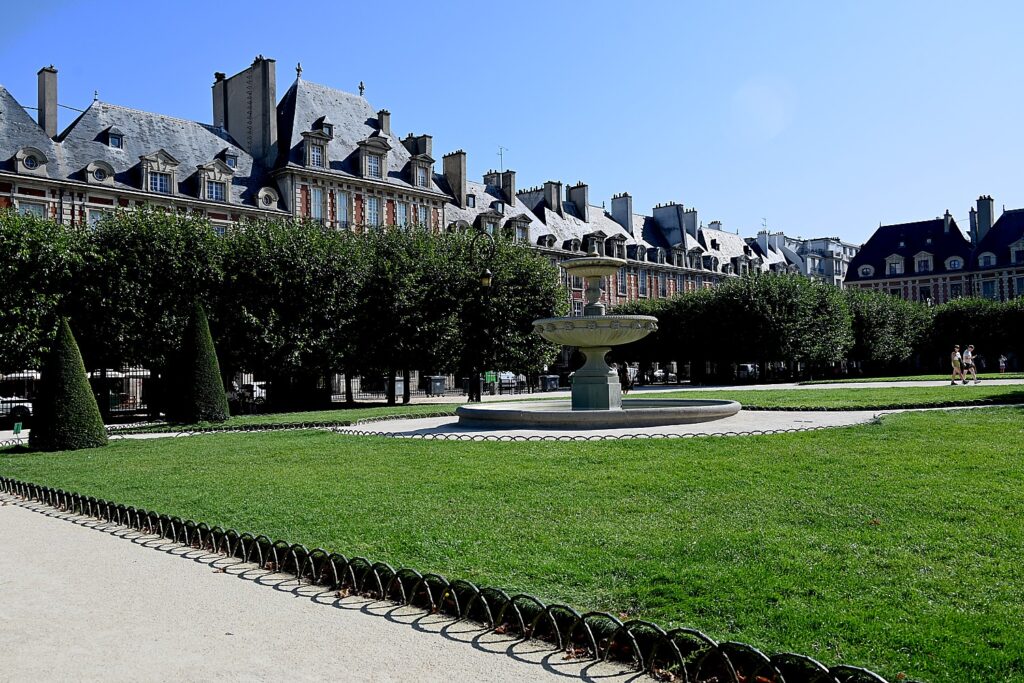
Though I have on my mental wish list to visit the Victor Hugo Museum, I don’t realize that it is actually one of these townhouses on Places des Vosges. (Years ago, I actually visited Victor Hugo’s “home in exile” on the quaint Channel Island of Guernsey and found it fabulous). But I get distracted and forget to look for it when I leave the square.
This is a huge regret – “Discover the private world of Victor Hugo. Get to know the man, the visionary artist, the proactive thinker and, of course, the writer of genius,” the museum promises. The museum incorporates the apartment that Victor Hugo rented from 1832 to 1848 is located on the 2nd floor of 6, Place Royale (now Place des Vosges). Its layout takes you through his life by means of the furnishings, objects and works of art that he created himself, owned, or are related to his writing.
While living in this apartment, Hugo wrote some of his major works: Mary Tudor, Ruy Blas, Les Burgraves [The Commanders], Les Chants du crépuscule [Songs of Twilight], Les Voix intérieures [Inner Voices], Les Rayons et les Ombres [Beams and Shadows], a large part of Les Misérables, and the beginning of The Legend of the Ages and Contemplations.
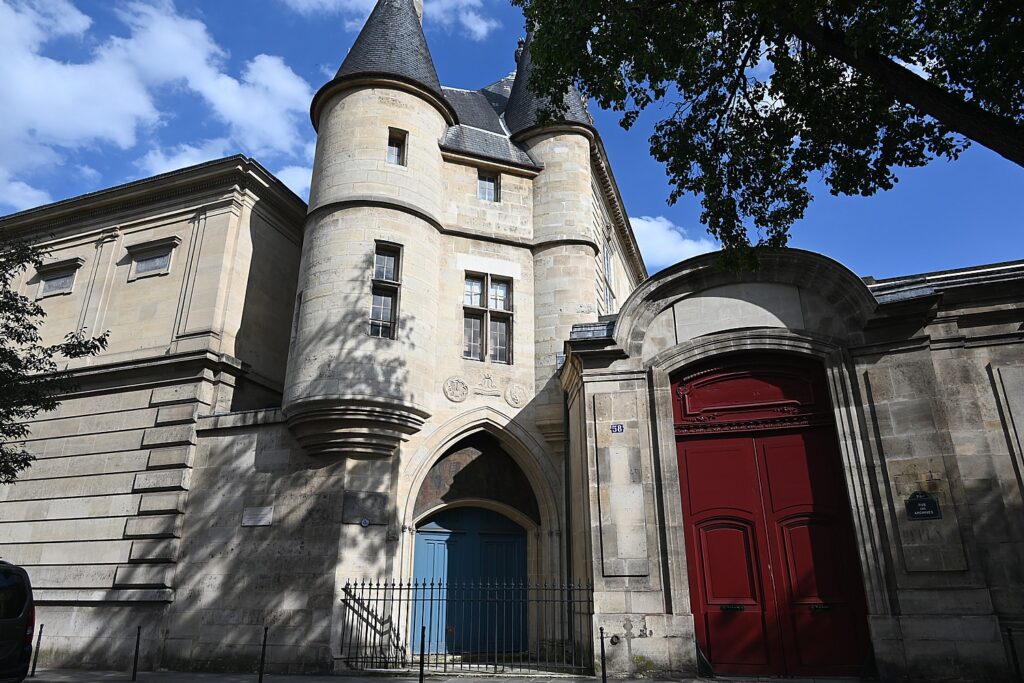
More than the writer’s house, the Maison de Victor Hugo is an important museum with a collection of 50,000 works of art- paintings, drawings, sculptures, prints, photographs, objects, a library, and collection of manuscripts and archives, all bearing witness to the life and work of Victor Hugo.
(Booking in advance is not required but is recommended. Admission to the museum’s permanent collections is free; an admission is charged for special exhibitions.)
Maison de Victor Hugo, place des Vosges, 6 place des Vosges, 75004 Paris,
Phone : 01 42 72 10 16; open 10-6, Tuesday-Sunday, https://www.maisonsvictorhugo.paris.fr/en/paris/museum/visit-apartment-today
(Add to my regret: I discover too late that in the Marais district is an Henri Cartier-Bresson Foundation, celebrating the ground-breaking photographer and founder of Magnum and photography, at 79 Rue des Archives, 75003 Paris, www.henricartierbresson.org)
Musee Carnavalet
But leaving the Square in the opposite direction from Maison de Victor Hugo (why I didn’t see it), I happen upon the Musee Carnavalet, dedicated to recounting the history of Paris and its inhabitants. It is absolutely fabulous – for the story, the artifacts, the art it presents, and it answers the question I had been wondering about: how Paris, as fabulous a city as it is, came to be.

The museum occupies two neighboring historic mansions: the Hôtel Carnavalet, was purchased by the Municipal Council of Paris in 1866 and opened to the public in 1880 (the oldest of Paris city museums); and the former Hôtel Le Peletier de Saint Fargeau which was annexed and opened to the public in 1989. Both are exquisite.
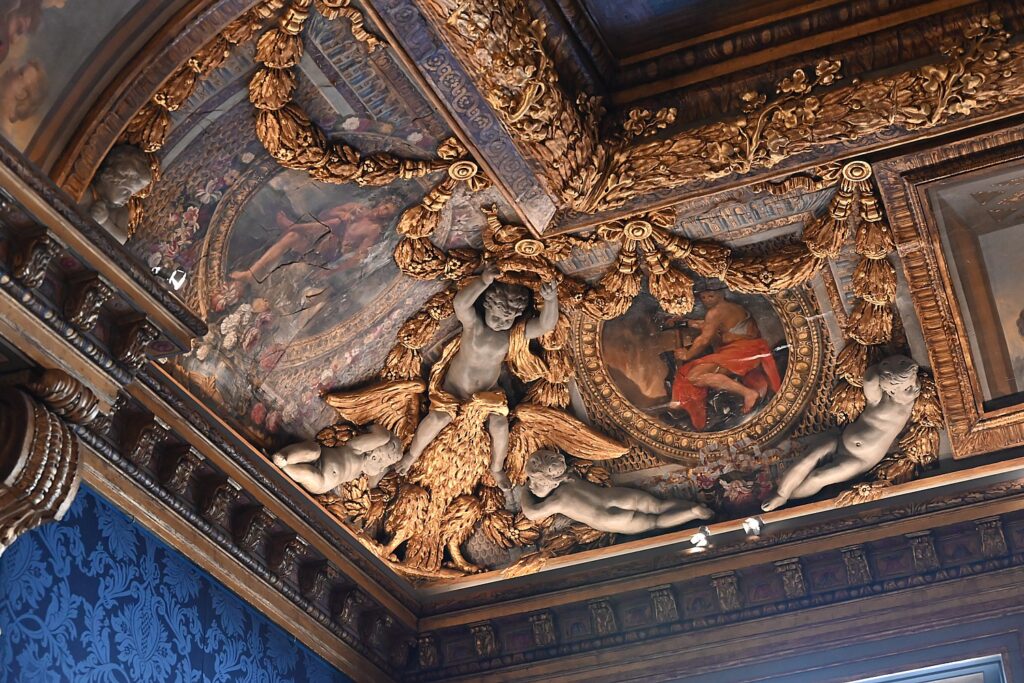
The Carnavalet, which dates from the 16th century, contains stunning furnished rooms from different periods of Paris history, historic objects, and a huge collection of paintings of Paris life depicting the city’s history and development, as well as its notable characters. There is a huge collection of antiques and artifacts from the French Revolution that bring this era to life in your mind (I note a portrait of Ben Franklin); from the Second Republic of 1848, and the siege of the commune in 1870 (the era depicted in Hugo’s “Les Miserables”). The horror of the Nazi occupation is also represented.
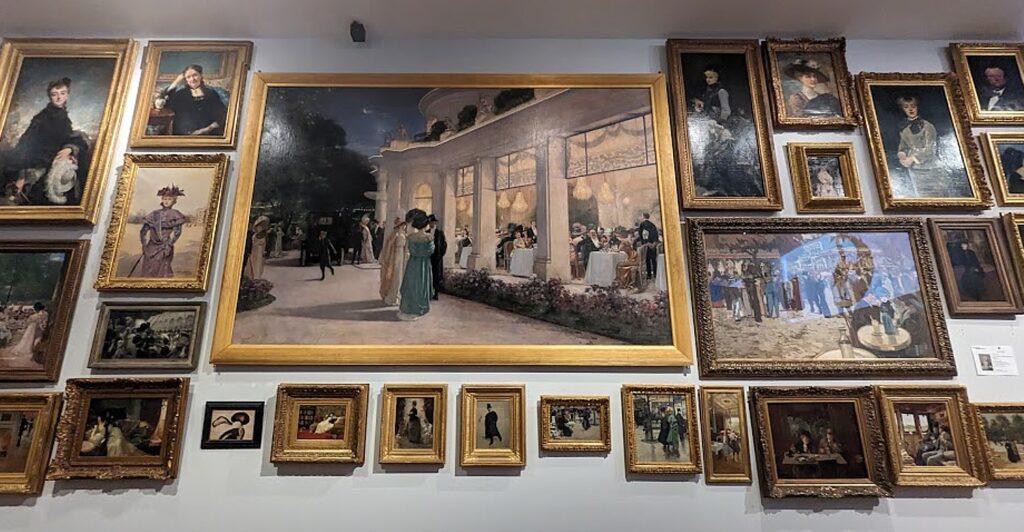
You come to a grand room that looks like the 19th century art salons the painters would exhibit in, with its walls filled with works by artists including Joos Van Cleve, Frans Pourbus the Younger, Jacques-Louis David, Hippolyte Lecomte, and Simon-Auguste.
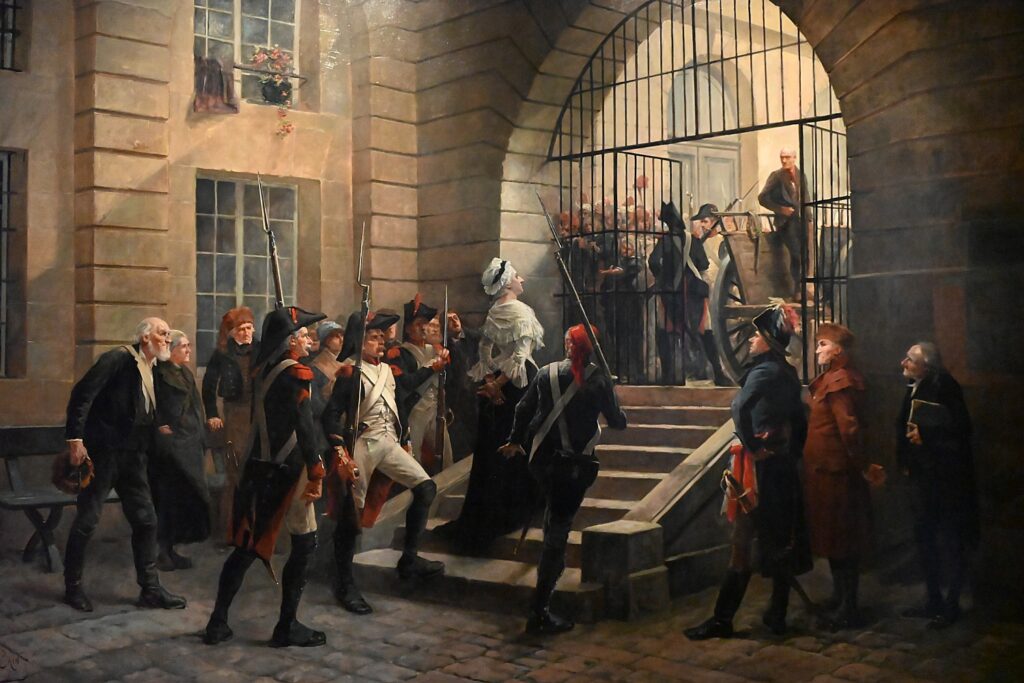
“At the crossroads of archaeology and history, the decorative arts and fine arts, urban history and social anthropology, the museum provides the keys to understanding the history of this unique city-capital-metropolis.”
It houses both well-known masterpieces along with little known treasures that tell the complex story of Paris, from its origins to present day, spanning 8,500 years and holds a mind-boggling 625.000 objects, presented in 85 permanent exhibition rooms
You need to spend at least two hours here. (Tuesday-Sunday, 10-6)
Musée Carnavalet, 23 Rue de Sévigné, 75003 Paris, http://carnavalet.paris.fr/en
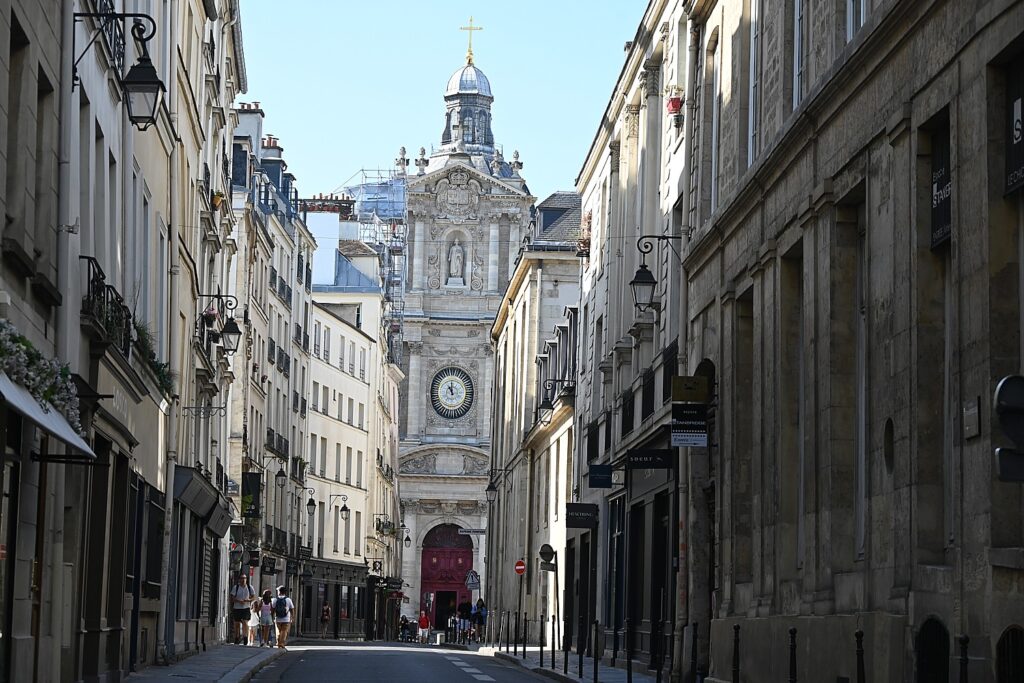
Carnavalet Museum, which proves a highlight of my Paris stay and the best reason for just wandering around, is one of the 14 City of Paris’s museums that have been incorporated since January 1, 2013, in the public institution Paris Musees. Others include: Catacombes de Paris, Crypte archéologique de l’Ile de la Cité, Maison de Balzac, Maison de Victor Hugo – Hauteville House (and in Guernsey), Petit Palais City of Paris Museum of Fine Arts, Musée d’Art Moderne de la Ville de Paris, Musée Bourdelle, Musée Cernuschi, Museum of Asian Art, Musée Cognacq-Jay, Musée Galliera, Museum of the General Leclerc and the Paris’ Liberation – Jean Moulin Museum, Musée de la Vie Romantique, Zadkine Museum
The Musée Picasso-Paris
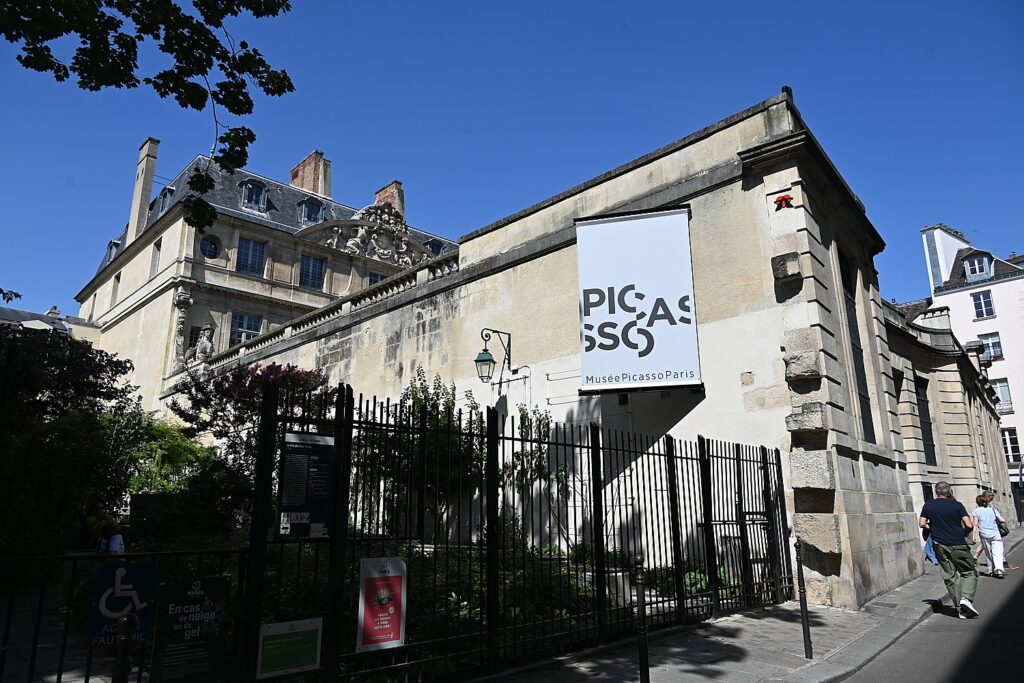
I set out next for the The Musée Picasso-Paris which is also in the Marais district – housed incongruously (considering Picasso’s art) in another classic historic mansion. The museum makes the claim to “the world’s richest public collection on Picasso” with 297 paintings, 368 sculptures and 3D works, 200,000 archived items, 92 illustrated books by Picasso. It also boasts a collection of 50 pieces of furniture by Diego Giacommetti.
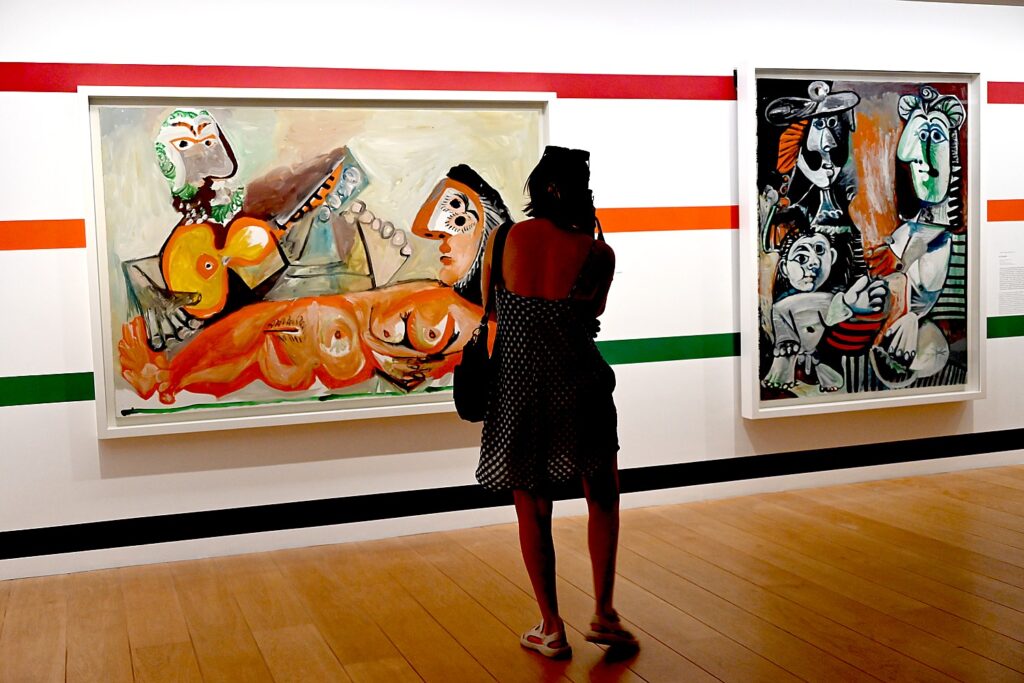
Musée National Picasso-Paris, 5 rue de Thorigny, 75003 Paris, https://www.museepicassoparis.fr/en
Museum of Jewish Art & History
From the Picasso Museum, I find my way to the Musée d’Art et d’Histoire du Judaïsme (Museum of Jewish Art & History).
As I walk up Rue de Place Republic to Rue de Temple, I find a marker that says 76,000 Jews were deported by Nazis to concentration camps; 2000 returned. Among those who were deported were the residents of 71 Rue de Temple, a 17th century historic mansion which today houses the Jewish Museum (mahJ), and when you first go in, there is a sort of tribute to them.
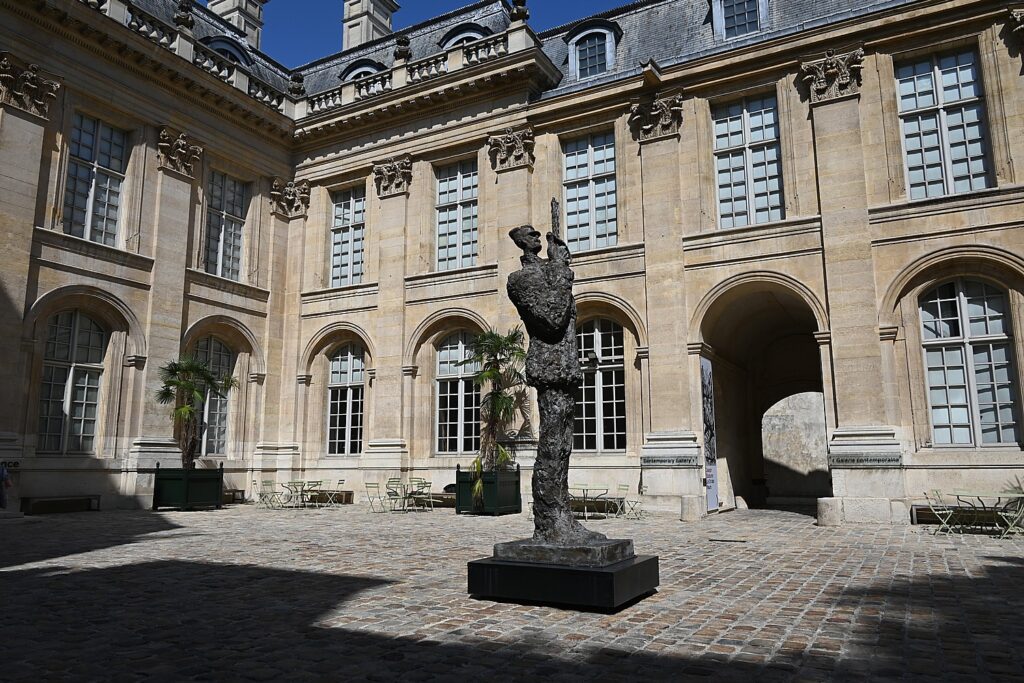
The museum traces Jewish artistic and cultural heritage, focusing on the history of the Jews in France since the Middle Ages to the 20th century, and evoking the communities of Europe and North Africa. Its collection, which it boasts is one of the finest in the world, comprises religious objects, manuscripts, textiles, and archival documents, such as concerning the Dreyfus Affair. (A statue of Dreyfus is in the courtyard at the entrance to the museum).
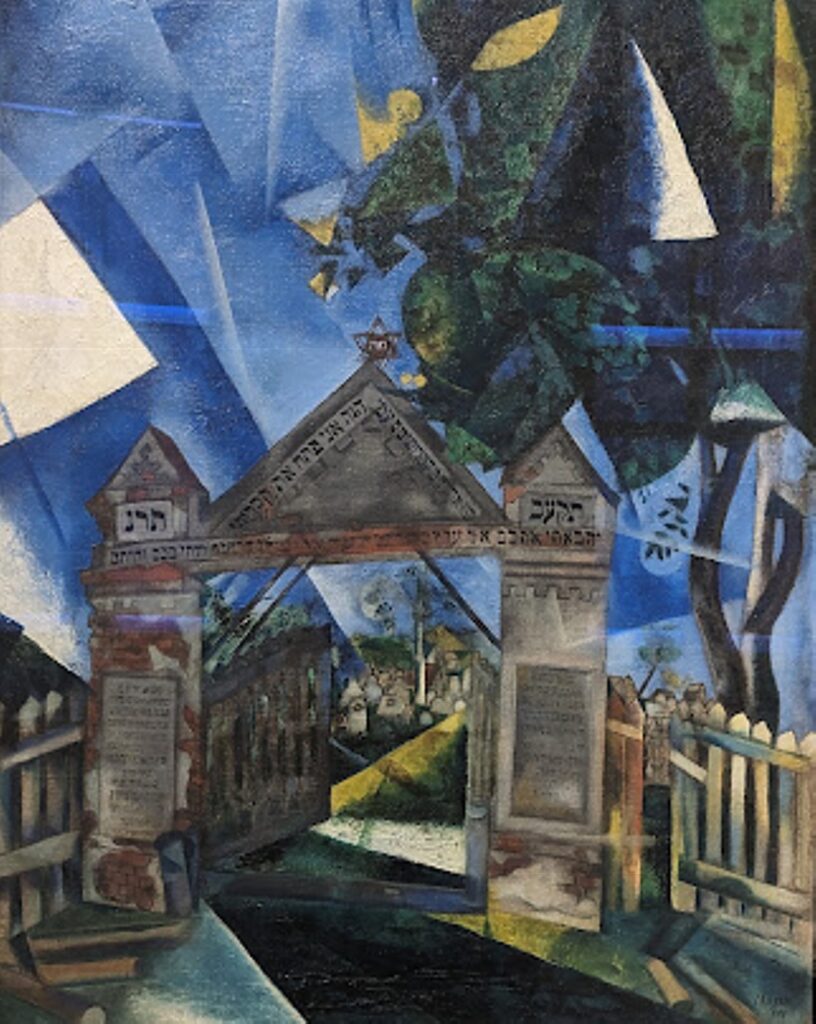
Special emphasis is given to the Jewish presence in the arts. The museum’s collections include works of art from painters of the School of Paris, Marc Chagall, Kikoine Soutine and Amedeo Modigliani and contemporary artists such as Christian Boltanski and Sophie Calle.
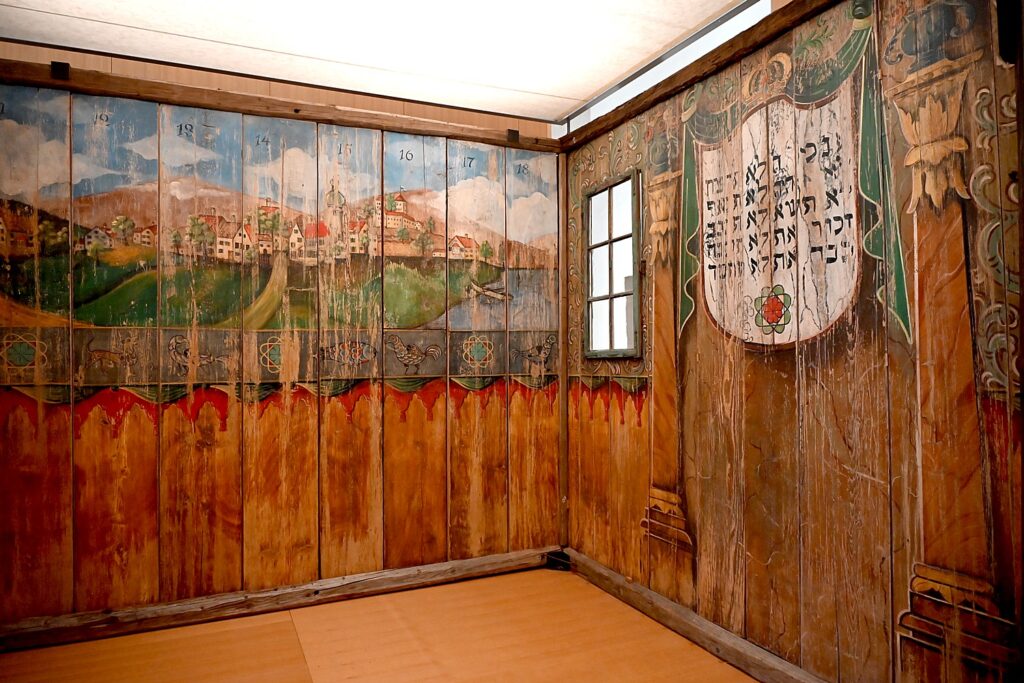
I find the exhibit more about Jewish ritual objects and such, than it is about Jewish history, culture and art – but I am really at a disadvantage in understanding since there are no English translations.
Musée d’Art et d’Histoire du Judaïsme, Hôtel de Saint-Aignan, 71 Rue du Temple, 75003 Paris, France, https://www.mahj.org
Next I head toward the Place de la Bastille where the notorious Bastille prison once stood, until it was stormed and destroyed between 14 July 1789 and 14 July 1790 during the French Revolution. No vestige of the infamous prison remains. Instead, the July Column (Colonne de Juillet) commemorating the July Revolution (1830) at the center of the square and the Opera house.
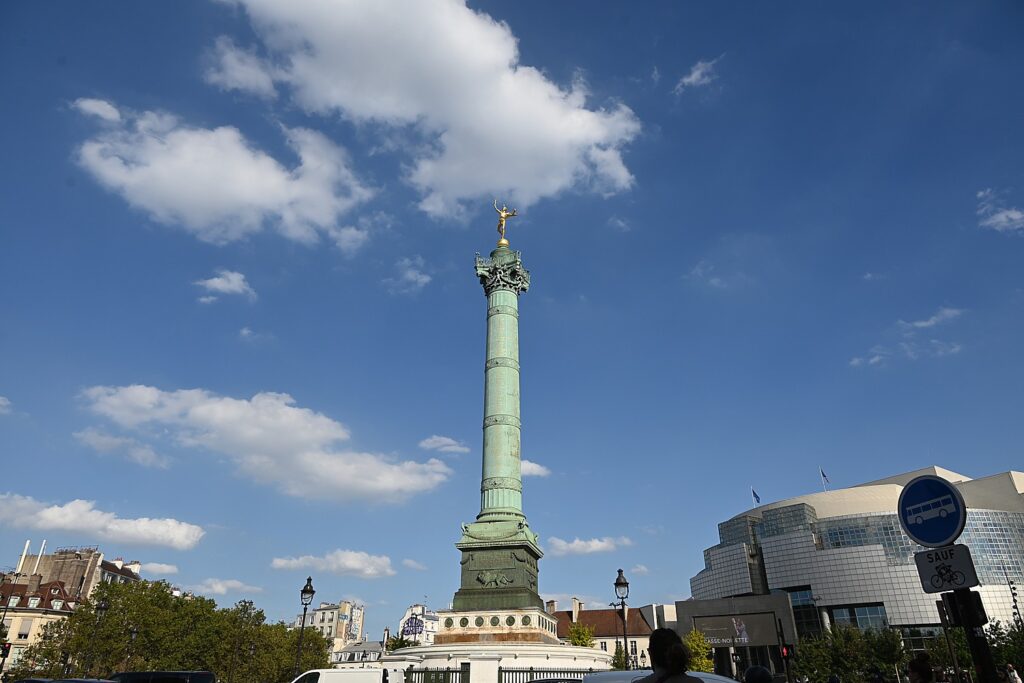
And while the square is now the site of concerts, cafes and nightclubs, it is also often the centerpiece for political demonstrations.
Another square, the Place Royale, which is close to my hotel, Le 20 Prieure Hotel, is also important for France’s history, but today is a place for skateboarders, misting station who seem to be completely unimpressed by the fabulous plaques, reliefs and inscriptions that decorate the statue at its center.
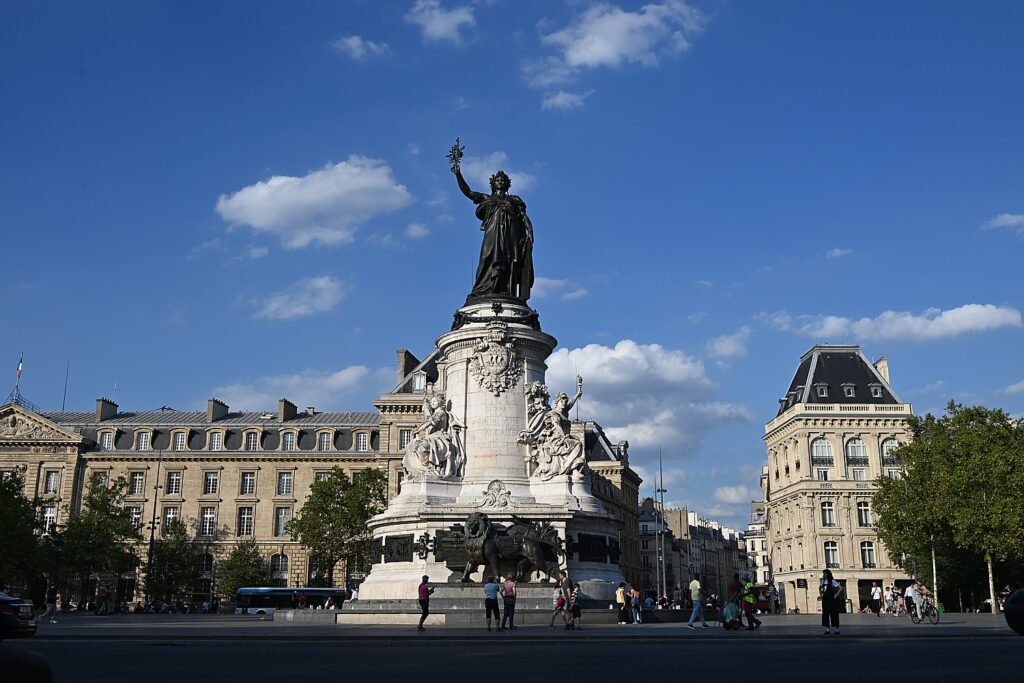
Many of these attractions are included in the Paris Museum Pass, http://en.parismuseumpass.com/ and Paris Pass (ParisPass.com).
More planning help from the Paris Tourist Office, https://parisjetaime.com/eng/. Online ticketing at https://parisjetaime.com/eng/tickets.
For Olympics planning (and where you can purchase tickets that become available), https://www.paris2024.org/en/
Next: Day 4 in Paris: Montmartre
See also:
ROMANCE IS AT THE HEART OF THE HOTEL NAPOLEON IN PARIS, CITY OF LOVE
VISITING PARIS THIS YEAR? PLAN IN ADVANCE
4 DAYS IN PARIS: MUSEE D’ORSAY HIGHLIGHTS DAY 1
4 DAYS IN PARIS: LE LOUVRE HIGHLIGHTS DAY 2
_______________________
© 2024 Travel Features Syndicate, a division of Workstyles, Inc. All rights reserved. Visit goingplacesfarandnear.com and travelwritersmagazine.com/TravelFeaturesSyndicate/. Blogging at goingplacesnearandfar.wordpress.com and moralcompasstravel.info. Visit instagram.com/going_places_far_and_near and instagram.com/bigbackpacktraveler/ Send comments or questions to [email protected]. Tweet @TravelFeatures. ‘Like’ us at facebook.com/NewsPhotoFeatures
